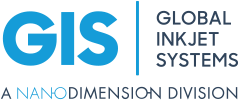We are moving into a new era of industrial digital inkjet printing with increased printhead capability and high data rate drive electronics, resulting in faster print speeds and higher resolution.
Ideally, inkjet printheads, substrate handling systems and ink dynamics should be perfect; however, the complex interaction between these components means that imperfections resulting in print defects are common. We unpack some common print defects that can occur on an industrial inkjet printing system and show you how, with GIS Atlas IQ® Tools intelligent software, you can deliver effective compensation to ensure superior print performance every time.
The process of achieving maximum image quality and performance starts with screener selection and Screener Optimisation. This is followed by calculating Channel Linearisation, Nozzle Density Compensation and Colour Profiling, and lastly applying these along with Missing Nozzle Compensation and Dynamic Image Registration (if required) to the printed output.
Screener Optimisation
Ultra-fast binary and greyscale screeners are crucial to achieving the best image reproduction to attain the best print. This allows top image quality conversion of contone images to produce smooth grey-level transitions, while maintaining sharp line detail when working with a limited number of printhead grey levels. This is balanced with the need for speed of converting contone images to screened output to achieve high speed inline RIP-on-the-fly or rapid offline RIP-to-file – a crucial factor in press performance. While screener selection is most strongly associated with the resulting desired visual image, the need to balance this with RIP speed is most evident where inline RIP-on-the-fly is required, such as variable data printing, as the speed of screener will directly impact the press speed and hence the throughput and productivity. GIS Screeners are considered the most optimised and highest performance screeners on the market, allowing for inline RIP-on-the-fly to maximise press usage and profitability for the press operator.
Channel Linearisation
This ensures that the printer maps contone values evenly throughout the scale, from 0-100%, which makes multiple printers behave in a similar predictable way and colour management easier. Control is achieved by printing individual channel linearisation test charts for each process colour, measuring the printed charts with a densitometer, and importing the measurement data into the RIP. This is then followed by Colour Profiling.
Nozzle Density Compensation
This adjusts every pixel in the original image with the aim of producing the same output print density for the same input density of the original image for every nozzle. The GIS Printhead Profiler tool can create a density test pattern, and, once this has been printed and scanned, nozzle-to-nozzle density is measured across the printhead array at a range of grey levels, resulting in a Nozzle Density Compensation that can subsequently be used to adjust the printed image. The application of these corrections is tightly integrated with the screener software to achieve the fastest correction possible and maintain the highest possible performance of the datapath from original image file to printed output.
Missing Nozzle Compensation
This reduces the visibility of missing nozzles and is tightly integrated with the screeners to maintain optimal performance. In an ideal world, all printhead nozzles would be perfect; however, due the size and number within a printhead this is invariably not the case. Misalignment of, or even blocked or damaged nozzles can be masked by software, thereby removing tell-tale faint lines or missing lines in the final printed image. It does this by adjusting neighbouring nozzles, giving the impression that all nozzles are active.
Colour Profiling
This ensures that when process colour channels are used together, they accurately represent the intended output colour, as the combination of the process colours and laydown order can significantly affect the resulting printed output colour. As with Channel Linearisation, colour test charts are printed, and spectral measurements are made to calculate colour profiles such as the International Colour Consortium (ICC) profiles. The linearisation and colour profiling processes are typically completed together. Each print mode (resolution, grey level, process colours, screener type, substrate, and print speed) will most likely need unique Channel Linearisation and Colour Correction profiles which are then applied to every printed image. Colour Correction profiling is typically completed together with Channel Linearisation.
Colour Registration
This is critical to accurate colour and repeatable colour reproduction and general image quality. GIS has a range of tools for printhead alignment that can be implemented during system configuration or dynamically during printing. Applications not only include colour channel registration but also additional varnish registration on pre-printed substrate.
Dynamic Registration
This is typically used for applications such as hybrid printing presses, where digital print is being applied to pre-printed analogue print, or varnishing applications where the varnish layer needs to be applied to pre-printed substrate. At GIS we have a range of software solutions that can be integrated with real-time camera-based position measurement allowing real-time alignment, rotation, and skew correction, or implemented via user input interfaces.
The GIS Atlas IQ Tools are now available within the GIS Atlas Software Suite, enabling customers to fully optimise their print quality and achieve superior print performance. These are available as bundled software, standalone or SDKs, and are compatible with GIS and 3rd Party RIP solutions, user interfaces and datapath drive electronics.

